Compact florescent bulbs (CFLs) are those swirley little guys that look like soft-serve ice cream cones. Actually, they come in a myriad of different shapes, sizes, and colors of light. Economically speaking, they’re a great deal, too. CFLs cost a bit more than an incandescent, but use about a quarter as much energy and last many times longer (usually around 10,000 hours). It is estimated that a CFL pays for its higher price after about 500 hours of use. After that, it’s money in your pocket. Also, because CFLs release less heat, not only are they safer, but your cooling load is less in the summer. CFLs aren’t hard to find anymore, and many cities will give them away for free. Wal-Mart has plans to sell 100 million of them.
2. Get the LEDs out
LEDs are a definite TreeHugger favorite. LEDs, or light emitting diodes, are a technology that allows for extremely energy efficient and extremely long-lasting light bulbs. LEDs are just starting to hit the consumer market in a big (read affordable) way and still cost quite a bit more than even CFLs, but use even less energy and last even longer. An LED light bulb can reduce energy consumption by 80-90% and last around 100,000 hours. They even light up faster than regular bulbs (which could save your life it there are LEDs in the brake lights of your car). They are almost always more expensive presently, but we have seen the cost go down steadily. It’s no coincidence that the Millennium Technology Prize went to the inventor of the LED.
Most LED lamps on the market have the bulbs built into them, so you buy the whole unit. For screw-in bulbs, check out Ledtronics, Mule, and Enlux. For desk lamps, check out a few affordable ones from Sylvania and Koncept. For more designer models, look at LEDs from Herman Miller and Knoll. Vessel rechargeable accent lamps represent some of the interesting new things LEDs can do as well.
3. Materials
Light isn’t all about the bulbs, though. Having eco-friendly lamps and light fixtures is key to greening your lighting. When scouting for new gear, keep your eyes out for lamps made with natural, recycled, or reused materials. Lights made from recycled materials include metal, glass, or plastic, and natural materials can include felt, cloth or wood. Interesting lamps that use reclaimed materials include these made from traffic signal lenses, and these made from wine bottles. Also, don’t be shy about borrowing ideas for reuse in your own projects (see DIY).
4. Disposabulb
Fluorescents last a long time, but when they’re dead, they have to be properly disposed of. CFLs, like all florescent bulbs, do contain a small amount of mercury, which means they definitely can’t be thrown in the trash. Every city has different services for recycling, so you’ll need to see what’s offered in your area. LEDs, to our knowledge, do not contain mercury, but the jury may still be out on how to best recycle them.
5. Wall warts
Power adaptors, or “wall warts” as they’re affectionately called, are those clunky things you find on many electrical cords, including those attached to lamps and some light fixtures. You’ll notice that they stay warm even when their device is turned off. This is because they in fact draw energy from the wall all the time. One way to green your lighting is to unplug their wall warts when not in use, attached lights to a power strip and turn off the whole switch when not in use, or get your hands on a “smart” power strip that knows when the devise is off.
6. DaylightingBy far, the best source of light we know is (yes, you guessed it) the sun, which gives off free, full-spectrum light all day. Make the most of daylight by keeping your blinds open (sounds obvious but you might be surprised). If you want to go a little farther, put in some skylights, or, of you are designing a home or doing a renovation, put as many windows on the south-facing side of the house as possible (or north-facing if you live in the southern hemisphere). To take it even further, sunlight can be “piped” inside via fiber optics and other light channeling technologies.







0 comments:
Post a Comment